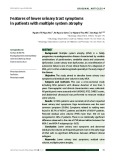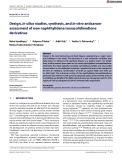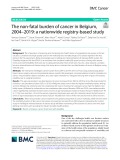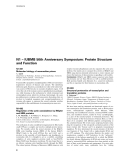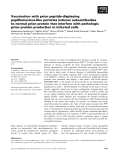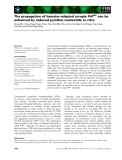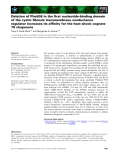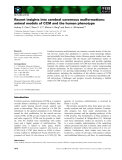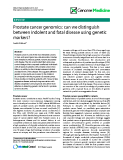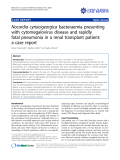
Fatal disease
-
Multiple system atrophy (MSA) is a fatally progressive neurodegenerative disease characterized by variable combinations of parkinsonism, cerebellar ataxia and autonomic dysfunction. The study aimed to describe lower urinary tract symptoms and residual urine volume in early MSA.
 7p
7p  viormkorn
viormkorn
 27-09-2024
27-09-2024
 5
5
 2
2
 Download
Download
-
. In vitro biological evaluation revealed the most active compound 4d with an inhibitory concentration of 42.87 μM against K562 and 47.42 μM on A549 cells. The anticancer activity of this naphthylidene isoxazolidinedione derivative was evident by cell cycle and apoptosis assays, which showed arrest of the G2/M phase (65.6%) of the K562 cells and induction of apoptosis with 21.47% apoptotic cells as compared to 0.2% of untreated cells, respectively.
 10p
10p  dianmotminh02
dianmotminh02
 03-05-2024
03-05-2024
 7
7
 3
3
 Download
Download
-
The importance of assessing and monitoring the health status of a population has grown in the last decades. Consistent and high quality data on the morbidity and mortality impact of a disease represent the key element for this assessment.
 10p
10p  vielonmusk
vielonmusk
 21-01-2022
21-01-2022
 16
16
 1
1
 Download
Download
-
Transmissible spongiform encephalopathies (TSE) are fatal neuro-degenerative diseases of humans and animals. The underlying infectious agent, the prion, accumulates not only in the central ner-vous system (CNS) but also in secondary lymphoid organs. I will revisit the role of the immune system in peripheral prion pathogen-esis, while focusing on the mechanisms by which extraneural and extralymphatic prion infectivity develops.
 64p
64p  fptmusic
fptmusic
 11-04-2013
11-04-2013
 36
36
 4
4
 Download
Download
-
Prion diseases are fatal neurodegenerative disorders caused by proteina-ceous infectious pathogens termed prions (PrP Sc ). To date, there is no pro-phylaxis or therapy available for these transmissible encephalopathies. Passive immunization with monclonal antibodies recognizing the normal host-encoded prion protein (PrP C ) has been reported to abolish PrP Sc infec-tivity and to delay onset of disease.
 12p
12p  galaxyss3
galaxyss3
 21-03-2013
21-03-2013
 37
37
 3
3
 Download
Download
-
Transmissible spongiform encephalopathies (TSEs), or prion diseases, are fatal neurodegenerative disorders caused by an infectious agent termed a prion, which can convert normal cellular prion protein (PrP C ) into a patho-logically misfolded isoform (PrP Sc ). Taking advantage of protein misfolding cyclic amplification (PMCA), a series of experiments was conducted to investigate the possible influences of pyridine nucleotides on the propaga-
 10p
10p  vinaphone15
vinaphone15
 27-02-2013
27-02-2013
 40
40
 2
2
 Download
Download
-
The primary cause of cystic fibrosis (CF), the most frequent fatal genetic disease in Caucasians, is deletion of phenylalanine at position 508 (F508del), located in the first nucleotide-binding domain (NBD1) of the CF transmembrane conductance regulator (CFTR) protein.
 13p
13p  vinaphone15
vinaphone15
 25-02-2013
25-02-2013
 32
32
 2
2
 Download
Download
-
Cerebral cavernous malformations are common vascular lesions of the cen-tral nervous system that predispose to seizures, focal neurologic deficits and potentially fatal hemorrhagic stroke. Human genetic studies have iden-tified three genes associated with the disease and biochemical studies of these proteins have identified interaction partners and possible signaling pathways.
 8p
8p  mobifone23
mobifone23
 18-01-2013
18-01-2013
 30
30
 4
4
 Download
Download
-
Tuyển tập báo cáo các nghiên cứu khoa học quốc tế ngành y học dành cho các bạn tham khảo đề tài: Prostate cancer genomics: can we distinguish between indolent and fatal disease using genetic markers?
 7p
7p  panasonic02
panasonic02
 15-12-2011
15-12-2011
 35
35
 4
4
 Download
Download
-
Tuyển tập báo cáo các nghiên cứu khoa học quốc tế ngành y học dành cho các bạn tham khảo đề tài: Nocardia cyriacigeorgica bacteraemia presenting with cytomegalovirus disease and rapidly fatal pneumonia in a renal transplant patient: a case report...
 4p
4p  thulanh25
thulanh25
 07-12-2011
07-12-2011
 44
44
 4
4
 Download
Download
-
Among the subspecialties of internal medicine, medical oncology may have had the greatest impact in changing the practice of medicine in the past four decades, as curative treatments have been identified for a number of previously fatal malignancies such as testicular cancer, lymphomas, and leukemia. New drugs have entered clinical use for disease presentations previously either untreatable or amenable to only local means of therapy, such as surgery and irradiation.
 104p
104p  vanass
vanass
 01-04-2011
01-04-2011
 62
62
 9
9
 Download
Download
-
Intraperitoneal Abscesses Abscess formation is common in untreated peritonitis if overt gramnegative sepsis either does not develop or develops but is not fatal. In experimental models of abscess formation, mixed aerobic and anaerobic organisms have been implanted intraperitoneally. Without therapy directed at anaerobes, animals develop intraabdominal abscesses. As in humans, these experimental abscesses may stud the peritoneal cavity, lie within the omentum or mesentery, or even develop on the surface of or within viscera such as the liver.
 5p
5p  thanhongan
thanhongan
 07-12-2010
07-12-2010
 54
54
 4
4
 Download
Download
-
Harrison's Internal Medicine Chapter 104. Acute and Chronic Myeloid Leukemia Acute and Chronic Myeloid Leukemia: Introduction The myeloid leukemias are a heterogeneous group of diseases characterized by infiltration of the blood, bone marrow, and other tissues by neoplastic cells of the hematopoietic system. In 2006 the estimated number of new myeloid leukemia cases in the United States was 16,430. These leukemias comprise a spectrum of malignancies that, untreated, range from rapidly fatal to slowly growing.
 5p
5p  thanhongan
thanhongan
 07-12-2010
07-12-2010
 77
77
 5
5
 Download
Download
-
Other Hepatitis Viruses Hepatitis A virus is rarely transmitted by transfusion; infection is typically asymptomatic and does not lead to chronic disease. Other transfusion-transmitted viruses—TTV, SEN-V, and GBV-C—do not cause chronic hepatitis or other disease states. Routine testing does not appear to be warranted. West Nile Virus Transfusion-transmitted WNV infections were documented in 2002. This RNA virus can be detected using NAT; routine screening began in 2003, and more than 1000 blood donors have tested positive.
 5p
5p  thanhongan
thanhongan
 07-12-2010
07-12-2010
 75
75
 4
4
 Download
Download
-
Outcomes following both transplant and immunosuppression have improved with time. High doses of cyclophosphamide, without stem cell rescue, have been reported to produce durable hematologic recovery, without relapse or evolution to MDS, but this treatment can produce sustained severe fatal neutropenia and response is often delayed. New immunosuppressive drugs in clinical trial may further improve outcome.
 5p
5p  thanhongan
thanhongan
 07-12-2010
07-12-2010
 68
68
 4
4
 Download
Download
-
The Dichotomy of Inpatient and Outpatient Internal Medicine The hospital environment has transformed dramatically over the past few decades. In more recent times, emergency departments and critical care units have evolved to identify and manage critically ill patients, allowing them to survive formerly fatal diseases. There is increasing pressure to reduce the length of stay in the hospital and to manage complex disorders in the outpatient setting.
 5p
5p  ongxaemnumber1
ongxaemnumber1
 26-11-2010
26-11-2010
 91
91
 8
8
 Download
Download
-
Chapter 182 provides an overview of the AIDS epidemic in the world today. Here we will limit ourselves to a discussion of AIDS in the developing world. Lessons learned in tackling AIDS in resource-constrained settings are highly relevant to discussions of other chronic diseases, including noncommunicable diseases, for which effective therapies have been developed. We highlight several of these lessons below.
 5p
5p  tubreakdance
tubreakdance
 26-11-2010
26-11-2010
 90
90
 4
4
 Download
Download
-
Overdose, including self-poisoning, causes bradycardia, heart block, hypotension and low output cardiac failure that can proceed to cardiogenic shock; death is more likely with agents having membrane stabilising action (see Table 23.1). Bronchoconstriction can be severe, even fatal, in patients subject to any bronchospastic disease; loss of consciousness may occur with lipid-soluble agents that penetrate the central nervous system. Receptor blockade will outlast the persistence of the drug in the plasma. Rational treatment includes: • Atropine (1-2 mg i.v.
 18p
18p  bigbaby87
bigbaby87
 03-09-2010
03-09-2010
 97
97
 11
11
 Download
Download
CHỦ ĐỀ BẠN MUỐN TÌM








